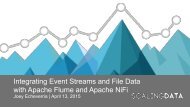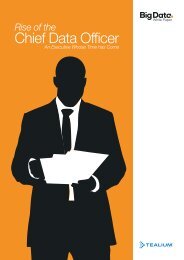NCDS-Summit-2013
NCDS-Summit-2013
NCDS-Summit-2013
Create successful ePaper yourself
Turn your PDF publications into a flip-book with our unique Google optimized e-Paper software.
nology advances, resulting in data that, even if stored on upto-date<br />
storage media, cannot be read because the software<br />
cannot be run. This problem can have significant implications,<br />
as evidenced by a recent article in the journal Science,<br />
in which researchers at the Max Planck Institute for Physics<br />
detail the negative impact that the loss of “old” experimental<br />
data had on the field of particle physics (Curry, 2011). The<br />
authors estimate that the computing and storage resources<br />
required to properly curate their data after the experiment<br />
had ended would have cost only 1% of the total research<br />
budget, but the return would have continued indefinitely.<br />
While the costs of generating data in genomics and particle<br />
physics aren’t comparable, the fundamental problems<br />
related to data storage and reuse are similar across fields.<br />
Finally, today’s information technologists are often inadequately<br />
trained to handle massive data sets. A survey of<br />
752 business executives, conducted by the Economist Intelligence<br />
Unit, found that 41% of respondents report a lack of<br />
skilled employees as a key barrier to processing data more<br />
rapidly, compared to 32% of respondents who view a lack of<br />
technology as a key barrier (Giles, 2012).<br />
Delineation of Phenotypes<br />
Discussion Moderator: Leslie Lange, PhD, Professor of Genetics, UNC-Chapel Hill<br />
Leslie Lange is a genetic epidemiologist, with a background in statistics and expertise in the harmonization of data sets<br />
across multiple cohorts. Dr. Lange’s research is focused primarily on the identification of genetic variants associated with<br />
complex cardiovascular disease–related phenotypes, and she has a particular interest in admixed and multi-ethnic populations.<br />
Dr. Lange is involved in several large genomic consortia, including the Cohorts for Heart and Aging Research<br />
in Genomic Epidemiology (CHARGE), the Continental Origins Genetic Epidemiology NeTwork (COGENT), and the<br />
NHLBI Exome Sequencing Project (ESP).<br />
Overview: The characterization of rich and complex phenotypes in the absence of standardization of data elements and<br />
harmonization of existing data sets presents significant challenges in the delineation of phenotypes. The lack of adequate<br />
tools and techniques to extract phenotype data from large data sets further complicates this matter.<br />
Whereas “genotype” refers to an organism’s genetic<br />
code, “phenotype” refers to an organism’s observed<br />
characteristics or traits, including physical properties, developmental<br />
profile, and behavior.<br />
An organism’s phenotype is influenced in large part by its<br />
genotype, although the environment, including one’s own<br />
behaviors, strongly affects phenotypes in ways that are<br />
poorly understood at present. Indeed, the fields of epigenomics<br />
and epidemiology focus on environmental influences<br />
on phenotype (Berger et al., 2009).<br />
A major challenge in the delineation of phenotypes is that<br />
the characterization of complex phenotypes is quite difficult.<br />
A phenotypic trait such as standing height is easy to<br />
define, but genetic studies rarely apply a uniform methodology<br />
to measure height (e.g., shoes on or off, subject maximally<br />
extended or relaxed). Other traits such as cardiovascular<br />
disease or hypertension can be quite difficult to define,<br />
with expert consensus difficult to achieve. For diseases even<br />
more complex such as psychiatric disorders (e.g., autism,<br />
depression), one rate-limiting step in identifying associated<br />
genomic variants is the definition of the phenotype itself<br />
(Fornito and Bullmore, 2012). Indeed, descriptors and<br />
vocabularies can vary within a given field, particularly for<br />
complex disorders that are influenced by sociological, cultural,<br />
psychological, and environmental factors (e.g., pain,<br />
substance abuse).<br />
A related challenge is that it is exceedingly difficult, if not<br />
impossible, to fully capture the richness of a phenotype with<br />
a finite set of variables. For example, consider a tumor. A<br />
pathologist can use a microscope to observe and describe<br />
a tumor over multiple focal planes and three-dimensional<br />
space. Capturing the full description of the pathologist’s<br />
report on that tumor with a quantitative data set presents<br />
an enormous challenge in data science. High-dimensional<br />
data on endophenotypes or biomarkers (i.e., quantifiable,<br />
heritable, biological traits that are associated with a given<br />
phenotype) may help overcome these challenges, but the<br />
analytical tools to validate and use these types of data are<br />
still under development (Vrieze et al., 2012).<br />
In addition, standard ontologies and terminologies are not<br />
fully developed and are necessarily evolving, which hampers<br />
efforts to completely characterize and compare genomic<br />
variants mapped to complex traits. Even if standard<br />
ontologies and terminologies are implemented, it is unclear<br />
whether data derived from different measurement systems<br />
(e.g., office versus home blood pressure measurements,<br />
self-reported versus biomarker-defined) can be legitimately<br />
compared or combined. Additional sources of variability include<br />
variable names (e.g., hypertension, HTN, high blood<br />
pressure), measurement units (e.g., mg versus mg/kg versus<br />
ml), and multiple measurements for a given variable (with<br />
or without a master list of measurement dates). Medicationrelated<br />
variables are often the most challenging to deal with<br />
in this context, as medication can be categorized as current<br />
or recent use (yes/no), coded numerically (with a master list<br />
that may or may not be available), or provided a text name,<br />
which may be listed as a Brand name or generic name.<br />
The absence of adequate publicly available documentation<br />
further hampers efforts to interpret data. For instance, in<br />
Data to Discovery: Genomes to Health / page 5




